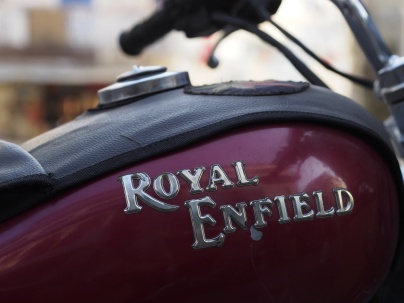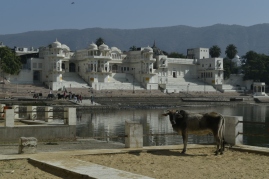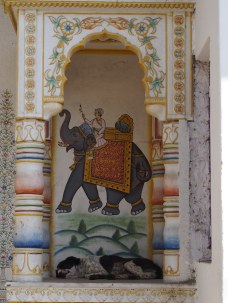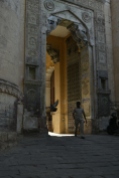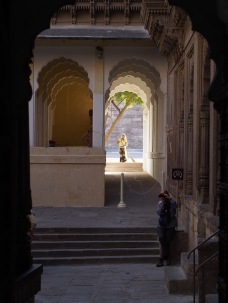Rajasthan, and India generally, seems a land of contrast. Leftwards leaning polititians in the UK sometimes complain about the UK’s “private wealth and public squalor”, compared with European societies: India takes this to spectacular extremes.
But, in India’s use and abuse society where rubbish piles high and waste is abandoned everywhere, not everyone is at one with this policy. Standing with a local man, beside a central shopping area in the bazaar at Jaipur, he mournfully stated that this was swept and clean this morning implying ‘and now look at it’. He shrugged his shoulders in despair. True enough, in the mornings we’ve seen ladies with twig brooms sweeping mess into dust pans, then emptying it into wheel barrows. Where next it goes I’m not sure but there are frequently rubbish mounds along the approach roads to towns and scorch marks where previous rubbish has been burnt, or earth and rubble piled on top; the reverse of our land fill sites I guess. But, the norm here is to drop rubbish in public areas, even by what would be very “respectable” people, businessmen, shopkeepers and the like. Of course, if the rubbish is edible, one if the many cows, dogs, or sometimes goats, will swiftly devour it, so all the discarded packaging is clean, and poorer people sift through the trash looking for stuff to reuse, including cow & camel dung, which are fuel – but there’s still a lot of rubbish left around. It’s different in private areas, which are often pristine, and certainly a fellow who dropped a wrapper in the grounds of Jodhpur’s palace, was very quickly directed to the bin. But public areas certainly are usually littered, shitty, and dusty.
This, together with the honking and hooting, are key things we’ve had to adjust to. Just as we’ve had to adapt to the local style of driving; pulling out or sweeping across traffic seemingly without looking at all & he who honks the loudest is surely coming through. This latter is never more evident than when traffic is trying to manoeuvre through road works or some other obstruction. One bully boy, horn blaring, will determinedly insist on forcing a way through, other traffic forced aside, including oncoming traffic with, apparently, right of way. There are frequently speed bumps at the boundaries of villages, or in towns, but again, plenty of drivers simply use these as an opportunity to overtake. Although India’s roads are generally very good, the drivers & riders are so bad it feels by far the most hazardous place we’ve found to cycle. However, it probably isn’t quite as bad as it feels, as speeds are generally low, and everyone assumes everyone else is a maniac and not looking where they’re going.
Away from all this madness, Rajasthan has been delightful. We’re back to the familiar waves, calls of ‘hello’ or ‘welcome’, and friendly hoots from people as our paths cross. This, together with, frequent requests for selfies to splash onto Facebook with a, ‘Look who I met’ comment. Once stopped it goes one of two ways: crowds appear from every corner, eager to look, poke, pull, gradually trying to engaged in conversation: Which country? Where are you going? Do you like India? A script we’re very familiar with. Alternatively, and rather less engaging, we are fair game for the hordes of children and sometimes adult village folk who often approach, fingers rubbing, with constant demands for money or gifts; seen elsewhere but more prevalent here. Or fingers out to you and back to their mouth or that of an infant/ child.
Rajasthan is one of the poorest regions in India. Back in the 70s literacy was estimated to be as low as 18%. It’s catching up but is still in the lowest three states of India and still claims the biggest gender gap in the country with women in villages at the thin end of the wedge. Projects like Roopraj Dhurry Udyog, where 42 families have formed a cooperative, help to raise the independence of women by developing cottage industries. Items are sold locally with all profits going to the artisans but there is a long way to go; the poverty is stark. Actually, although in theory “all profits” go to the artisans, we rarely get to meet any, and they’re very quiet. One suspects the lion’s share of profits are absorbed by the sleek looking men running the shops.
It’s been interesting to see the cast iron hand sewing machines frequently in action. We’ve previously donated 2 or 3 of these, 1930s Singers, to charitable organisations at home where they were serviced and sent to third world countries. Here they are still in action, still being serviced and still available to purchase brand new. Gid had a repair done. A quick job; less than 5 minutes, less than 15 pence. Every town or village can offer such a service.
Embarrassingly, while we waited at a level crossing in a small village, a local pointed out Clare’s back tyre was flat. We already knew it had a slow puncture but now it was indeed flat. We happened to be right outside a tyre repair place. In we went! They quickly fixed both slow and fast holes for 10 rupees.
In amongst a great deal of curious chat as they compared our bikes with theirs. Most Indian bikes are (to us) old fashioned roadsters from the 1950s, with one speed, rod brakes, and the old fashioned British Standard metal tab lamp bracket (which is never actually used, and we remember from our childhood is a completely crap design). A newer kids bike, mountain bike looking, but still one speed, was apparently 3,500 rupees – about 50 euros. I guess Tesco, at home, get pretty close to matching both the quality and price of that. Indians often ask how much our bikes cost: We’ve got into the habit of saying it’s about the same as one of their Honda Hero motorbikes, which are about 900 euros, same as the starting price for a decent tourer (before all the upgrades).
Rajesthan has been truly fascinating but I look forward to seeing a more balanced view of the county as we sweep back in an easterly direction towards Kolkata.
Top sights along the way:
On The Road
Villages, cows, decorated lorries, tuk tuks, the army on the move, wildlife. Surprisingly good roads and amazingly bad drivers.
Jaipur
We already wrote a bit about Jaipur, here’s Gid’s photos.
Pushkar
The lake, cows, monkeys, dodgy holy men with their ribbons and paint, new age travellers and view from the hilltop temple.
Jodhpur
Castle, palace, blue city.
Jodhpurs at Jodhpur
We saw a notice advertising a polo tournament – Jodhpur is a big army town, as well as the Maharajah’s traditions, although actually polo isn’t terribly old. We watched a British Army visiting team narrowly beat the President’s Bodyguard team by 3 1/2 to 3.
Jaisalmer
The roads to and from Jaisalmer, and our camel trek from there, were both rich in sightings of interesting Thar Desert wildlife.
Jaisalmer is twinned with West Sussex at least in the sense they both have a Hawker Hunter plane on a big pole. Ford’s, in Sussex, has more moss than Jaisalmer’s.
They both have military museums. Jaisalmer’s has more old tanks, Tangmere’s, in Sussex, has more old planes. Jaisalmer’s castle is more impressive, more open, and mostly older than Arundel’s.
See separate posting for our camel trek, and our way out of Rajasthan, via Ranakpur and Xmas in Udaipur, also has its own posting.





















